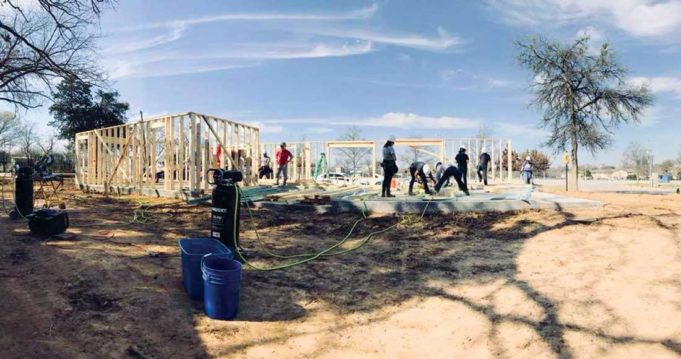Seniors and graduate students participating in the Parallel Construction Program through UTA’s College of Architecture, Planning and Public Affairs are really sweating the homework this semester. That’s because it involves hours of manual labor at the site of the single-family home the students are building for Housing Channel, a Fort Worth-based nonprofit that works to revitalize neighborhoods and provide affordable housing solutions.
Though most of the 19 students in the program headed by Josh Nason and Brad McCorkle will land office gigs once they receive bachelor’s or master’s degrees, Parallel Construction is helping them understand how construction crews create liveable structures from paper-drawn plans. In the process, the students are performing a good deed.
The learning experience takes place under watchful eyes. In addition to the supervision provided by Nason and McCorkle, professionals at Wall Homes are on hand as well. Wall, whose corporate headquarters is in Arlington, is Housing Channel’s “builder of record,” according to the nonprofit’s president, Donna VanNess.
Brad Bell, interim director of the School of Architecture, said the class provides “active learning in a real-world setting.” In addition to giving students experience at “swinging a hammer,” the program hones teamwork skills and teaches students how to cope with such things as budgets and rainouts, he said.
The house is being built at 820 Truman St. in Arlington, on a lot donated by Wells Fargo. It’s off Collins Street, in the shadow of AT&T Stadium. McCorkle said that neighbors were consulted before construction began. The house fits with the style of the older neighborhood, which was built in the late 1940s or early ’50s, he said.
It is the first single-family home built by UTA students but not the first student-driven construction project. Two years ago, students built pavilions. Last year, they built two “micro-houses” that will soon be auctioned. Proceeds will go back into the program or may be used to start a scholarship, Bell said.
The foundation for the Truman house was poured in late February. At that time, plumbing was done by professionals and inspections were conducted, Nason said. Before starting work at the site, students were drilled on safety procedures.
“We certainly have to be cautious,” Nason said, adding that he and McCorkle are “helicopter parents” who hover protectively over students. Licensed contractors are often onsite, too.
“Some of the jobs, we can’t do,” Nason said. “We don’t do the plumbing or the electrical because those have to be licensed professionals.”
He said that due to “tight schedules,” a professional framing crew is handling the framing of the roof, but students are framing the walls.
“The students get to interact with those trades,” McCorkle said.
The students are required to be onsite every Monday, Wednesday, and Friday from 2 to 6 p.m., which is considered class time. Nason and McCorkle are also onsite at the same time. At least one of them is present when smaller groups of students work at other times during the week and on weekends, which is considered their homework.
It’s a lot of work hours for Nason and McCorkle, but they don’t mind.
“I’ve been teaching 19 years, and I’ve been wanting to do this my entire career,” McCorkle said. “For me, spending 16, 18 hours a day onsite with students, yeah, I get tired, but I love doing it.”
Nason said that giving students hands-on training and seeing them realize their capabilities is the best part of the program for him.
“A lot of students like the balance” of classroom work and construction site work, Nason said.
More than 30 students applied to be in the class. Nason and McCorkle gave priority to those close to graduating who likely would not have another opportunity. Of the 19 selected, one student had supervised a framing crew in a previous profession and a handful had a small amount of construction experience. About two-thirds, however, had no construction experience at all, Nason said.
Students began working on the Truman Street house in a classroom setting last semester. The size, scope, budget, and location of the project were determined during that time, and students embarked on a design competition. Faculty members, professional architects, and representatives of Housing Channel and Wells Fargo were involved in selecting the winner, VanNess said. Faculty members and students then refined it.
McCorkle said that students were encouraged to focus not on how big a house they could build with the budget but rather on how to build an efficient yet comfortable space. The Truman Street house is just 1,560 square feet, but the design includes three bedrooms and two-and-a-half baths.
Under McCorkle’s guidance last semester, students learned how to obtain the city permits needed to get the project rolling.
Senior Annaliese Snidow, whose design was the one chosen, said she and her fellow students are loving the experience. The 22-year-old Dallas native is set to graduate in May.
“I think it’s a really great thing that they included this as part of their curriculum because not a lot of schools have it, and it definitely helps us realize the real-life factor of our design,” she said.
A number of individuals and businesses contributed to the project. Bell said that Dallas architect John Mullen has been “a key factor” in spearheading the Parallel Construction initiative and even donated money to the program.
As Parallel Construction’s client, Housing Channel provided the $150,000 needed for construction materials. The money was funneled to the nonprofit by the city, which obtained it through the U.S. Department of Housing and Urban Development’s HOME Investment Partnership Program.
Founded in 1991 by a housing task force formed by then-Fort Worth Mayor Bob Bolen and community leaders, Housing Channel partners with Tarrant County, the cities of Fort Worth and Arlington, and other entities to provide a variety of housing development services, including: a program for down payments and closing-cost assistance; acquisition, rehabilitation, and resale programs; homeowner counseling; and new construction of single-family residences.
Once construction has been completed, the Truman house will be sold on a first-come, first-served basis to a qualified Housing Channel client.
“The house is going to be an incredible opportunity for whoever gets the program completed, gets their documents in first, and has lender approval,” VanNess said.
Bell, Nason, and McCorkle said that as yet no project has been chosen for the 2018-2019 academic year, but they hope to continue the partnership with Housing Channel. This was happy news to VanNess.
“We’re hoping that this is just the first of many collaborative partnerships,” she said.
Nason said the goal is to finish the Truman house by May 5, which is the last day of classes.
“I think the real benefit in this program is not only the technical experience and skills that the students build but also the appreciation for the craft of making something,” he said.
VanNess, a UTA alumna and Arlington resident, said she believes the professionals at Wall Homes have enjoyed the Parallel Construction experience and she has, too.
“It’s just fun being around the students,” she said. “It’s fun to see their enthusiasm and their willingness to work hard.”












